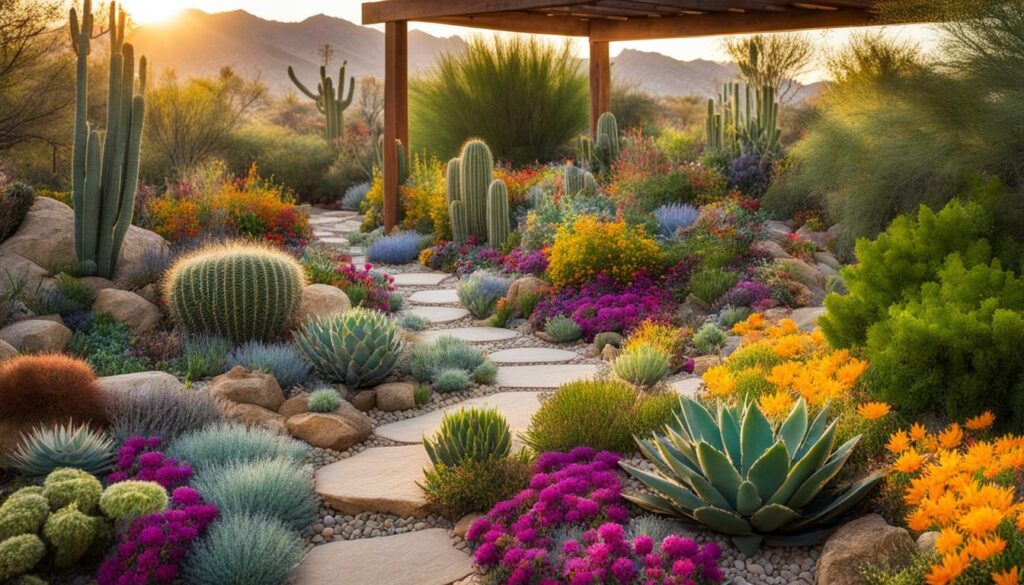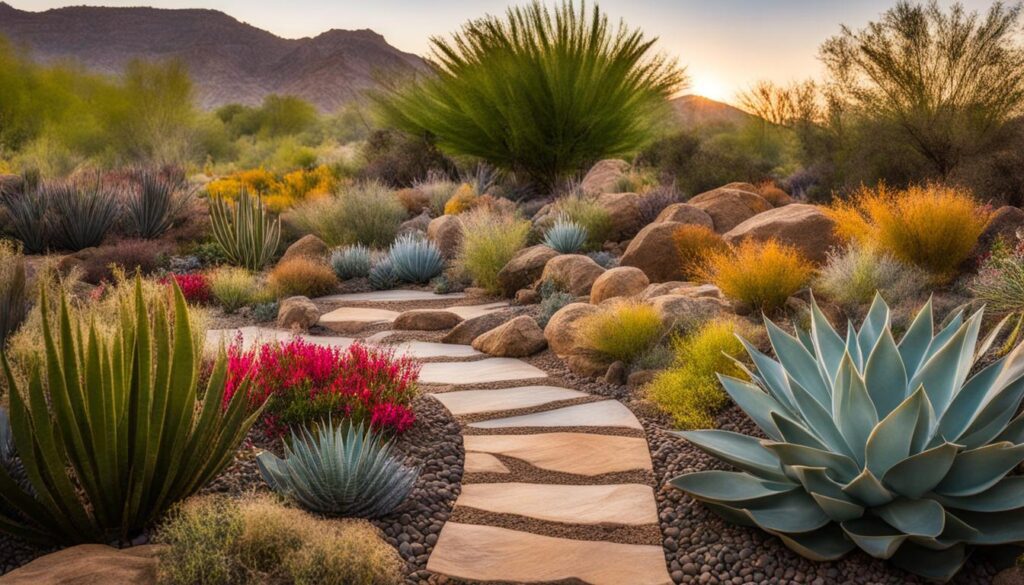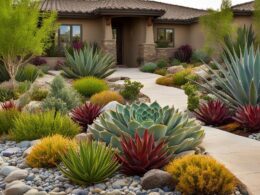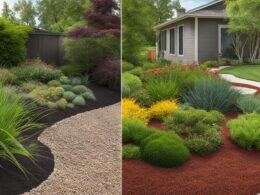Xeriscaping is a popular low-water gardening technique that is gaining popularity across the United States, particularly in dry regions like California. Contrary to popular belief, xeriscape gardens don’t have to be dull and filled with cacti and succulents. In fact, there is a wide variety of plants that can thrive in xeriscaping, ranging from succulents to leafy plants, flowering plants, and even trees. By selecting the right plants, you can create a lush, eco-friendly garden that requires minimal water and maintenance.
Key Takeaways:
- Choose a variety of plants for a diverse and visually appealing xeriscape garden.
- Xeriscaping principles help create a sustainable and water-efficient landscape.
- Ground covers and fairy gardens are excellent options for low-lying, drought-tolerant plants.
- Bedding plants and borders add color and texture to your xeriscape garden with minimal water and maintenance.
- Xeriscaping benefits include water conservation, reduced bills, and support for local ecosystems.
The Principles of Xeriscaping
Xeriscaping is based on a few key principles that are essential for creating a sustainable environment year-round. By following these principles, you can ensure that your xeriscape garden is both beautiful and water-efficient.
- Plan everything well in advance: One of the first principles of xeriscaping is careful planning. This involves considering your garden’s layout, location, and the specific needs of the plants you choose. By planning ahead, you can create a cohesive and water-wise landscape.
- Limit the use of turfgrass: Traditional lawns require a significant amount of water to stay lush and green. In xeriscaping, it’s advisable to reduce or eliminate the use of turfgrass and replace it with native or drought-tolerant plants. This not only conserves water but also reduces the need for regular mowing and maintenance.
- Choose plants with lower water needs: Selecting plants that are naturally adapted to your climate and require less water is a fundamental aspect of xeriscaping. These plants can thrive with minimal rainfall or irrigation, reducing the overall water consumption in your garden.
- Group plants with similar watering needs together: It’s wise to group plants with similar water requirements together in your xeriscape garden. This allows you to create irrigation zones and tailor your watering practices more efficiently, ensuring that each plant receives just the right amount of water it needs.
- Use targeted irrigation systems to reduce water waste: Investing in efficient irrigation systems, such as drip irrigation or soaker hoses, is vital for xeriscaping. These systems deliver water directly to the plants’ root zones, minimizing evaporation and ensuring maximum water efficiency.
- Mulch around plants to prevent water evaporation: Applying a layer of organic mulch around your plants helps conserve moisture in the soil by reducing evaporation. Mulch also helps suppress weeds and improves the overall health of your xeriscape garden.
- Maintain and prune plants to prevent excessive water requirements: Regular maintenance and pruning are important for xeriscaping. By removing dead or overgrown plant material, you can prevent excessive water requirements and promote the overall health and vitality of your garden.
By incorporating these principles into your xeriscape garden, you can create a sustainable landscape that conserves water, reduces maintenance, and enhances the beauty of your outdoor space.
Creating a Water-Wise Garden
The principles of xeriscaping go hand in hand with sustainable landscaping and water conservation. By implementing these practices, you can create a garden that not only minimizes water usage but also supports local ecosystems and reduces your environmental impact.
“Xeriscaping is all about making smart choices when it comes to landscaping. By selecting the right plants, using efficient irrigation methods, and practicing proper maintenance, you can have a beautiful garden that thrives while conserving water.”
Whether you live in a drought-prone area or simply want to reduce your water consumption, xeriscaping offers a practical and eco-friendly solution. By following the principles outlined above, you can create a stunning landscape that is both water-efficient and visually appealing. Take the first step towards sustainable gardening today!
Ground Covers and Fairy Gardens for Xeriscaping
When it comes to xeriscaping, ground covers and fairy gardens are excellent options for adding visual interest and texture to your landscape. These low-lying plants not only create a lush and beautiful effect but also help conserve water in dry regions. Here are some drought-tolerant ground cover options to consider:
- Sedum rubrotinctum (Jelly Bean Plant): This succulent features colorful, jelly bean-shaped leaves that turn red in full sun.
- Pachysandra procumbens (Allegheny Spurge): This evergreen ground cover has attractive foliage and delicate white flowers.
- Ophiopogon japonicus (Dwarf Lilyturf): This grass-like plant forms dense clumps and produces small purple flowers.
- Ophiopogon planiscapus (Black Mondo Grass): With its dark foliage, this plant adds a dramatic touch to any xeriscape garden.
These ground covers not only require minimal water but also serve as a natural weed suppressant, reducing the need for herbicides. They create a beautiful carpet-like effect while conserving water, making them perfect for xeriscape gardens.
Creating a Magical Fairy Garden
If you’re looking to add a touch of whimsy to your xeriscape garden, consider creating a fairy garden. Fairy gardens are miniature landscapes that mimic the enchanting world of fairies. Here are some plants that are perfect for fairy gardens:
- Thymus praecox (Woolly Thyme): With its tiny leaves and fragrant pink flowers, this plant adds charm to any fairy garden.
- Ajuga reptans (Carpet Bugleweed): This perennial ground cover features vibrant foliage and small blue flowers, attracting both fairies and pollinators.
- Heuchera sanguinea (Coral Bells): This plant offers a variety of vibrant leaf colors and small bell-shaped flowers, adding a pop of color to your fairy garden.
- Viola tricolor (Wild Pansy): Also known as Johnny Jump-Up, this delicate flower adds a whimsical touch to any fairy garden.
Remember to incorporate small accessories like fairy houses, miniature furniture, and tiny decorations to create a magical atmosphere. Fairy gardens are a delightful way to express your creativity while maintaining a water-efficient and sustainable xeriscape garden.
Adding ground covers and fairy gardens to your xeriscape garden not only enhances its beauty but also promotes water conservation. These low-maintenance, drought-tolerant plants provide an eco-friendly solution for creating a lush landscape that thrives in dry conditions. Embrace the versatility of ground covers and the enchantment of fairy gardens to transform your xeriscape garden into a sustainable oasis.
How Can Xeriscape Principles Help Me Choose the Best Plants for Sustainable Xeriscaping?
When considering the best plants for sustainable xeriscaping, it’s essential to incorporate xeriscape principles. By following sustainable gardening principles today, you can choose plants that require less water, are native to the region, and can thrive in low-maintenance landscapes. This will help conserve water and support a healthy ecosystem.
Bedding Plants and Borders for Xeriscaping
Bedding plants and borders are a fantastic choice for adding vibrant colors and textures to your xeriscape garden. These plants not only enhance the visual appeal of your outdoor space but also require minimal water and maintenance, making them perfect for sustainable xeriscaping. By incorporating drought-tolerant flowers and low-maintenance plants, you can create a stunning garden that thrives even in dry climates.
When selecting xeriscape bedding plants, consider options like Aloe brevifolia (Crocodile Aloe) and Salvia sonomensis (Sonoma Sage). These plants offer vibrant flowers and unique foliage, adding visual interest to your garden while conserving water. Another excellent choice is Salvia chamaedryoides (Germander Sage), which produces stunning blue flowers and attracts pollinators like bees and butterflies.
To create contrast and variety, you can also incorporate plants like Oxalis triangularis (False Shamrock) and Rohdea japonica (Japanese Sacred Lily) into your xeriscape borders. These plants have attractive foliage and thrive in low-water conditions, making them ideal for sustainable landscapes. Lycoris radiata (Equinox Flower) is another noteworthy option that adds a touch of elegance with its beautiful red blooms.
By opting for these xeriscape bedding plants and borders, you can enjoy a vibrant and visually appealing garden while conserving water and minimizing maintenance tasks. These low-water, low-maintenance plants not only save you time and effort but also contribute to a more sustainable future.

–>
Conclusion
Xeriscaping offers a practical and sustainable solution for your landscaping needs, providing a wide range of benefits. By incorporating drought-tolerant plants and following xeriscaping principles, you can create a beautiful, eco-friendly garden that requires minimal water and maintenance.
One of the key advantages of xeriscaping is its significant contribution to water conservation. By selecting plants that have lower water needs and implementing targeted irrigation systems, xeriscape gardens require much less water compared to traditional landscaping methods. This not only helps conserve water but also reduces your water bills.
In addition to saving water, xeriscaping supports local ecosystems by attracting pollinators and wildlife. By creating a habitat that provides food and shelter, you contribute to the preservation of biodiversity in your area.
Whether you opt for ground covers, fairy gardens, bedding plants, or borders, xeriscaping offers a wide array of options to suit your preferences and climate. Join the xeriscaping community today and take a step towards a more sustainable future!











